DOI:10.32604/iasc.2022.026154

| Intelligent Automation & Soft Computing DOI:10.32604/iasc.2022.026154 |  |
| Article |
Effective Channel Allocation for Hybrid Network Usage Between Wi-Fi and Cellular Network
1Saveetha Engineering College, Thandalam, Chennai, 602105, India
2Muthayammal Engineering College, Rasipuram, Namakkal, 637408, India
*Corresponding Author: M. Vanitha. Email: vanitha@saveetha.ac.in
Received: 16 December 2021; Accepted: 13 February 2022
Abstract: Hybrid networks are a rising innovation for maximizing wireless network coverage without any extra need for resources. This research paper focuses on effective channel allocation for Wireless Fidelity (Wi-Fi) and cellular networks. As a novel work in this area, the Beyond Access Point Coverage (BAPC) has been presented for adequately installing cellular networks on the unlicensed Wi-Fi spectrum. Networks can straightforwardly exploit Wi-Fi distributed coordination. Our BAPC commits and permits a combat-free period to cellular network subscribers and customary Wi-Fi subscribers to encourage concurrence. This research focuses on the maximization of combined subscriber affiliation and frequency channel distribution to improve hybrid network throughput and subscriber decency. The issue of Hybrid system usage is reduced by Hard Bargaining Borrowing Channel Solution (HBBCS), which is determined with a mathematical expression for the effective combat-free period length under a given subscriber connection. HBBCS-based usage of the channel under log-typical blurring, Rayleigh blurring, and Rician blurring spectrum model to analyze the proposed calculation are being estimated separately. Our investigation’s mathematical outcomes confirm successful framework execution maximization under the proposed HBBCS calculation against customary cellular network organization.
Keywords: Cellular network; wireless fidelity; HBBCS; BAPC; hybrid system
As the best wireless standards in cellular systems today, both Wi-Fi and cell networks have gone up against the difficulties of restricted limits with the exponential development of wireless traffic. Various hybrid wireless advancements have been created to improve channel proficiency, which includes huge Multiple Input Multiple Output (MIMO), subjective radio, microcells, and two-way correspondences. Essentially, the shortage of good channel allocation is a significant issue on wireless networks. Therefore, one of the most basic problems for the two systems is the combined allocation of their aggregate channel assets for the total coverage improvement [1–3]. Unlicensed frequency channels can be combined as micro-cells to improve both network throughput and power proficiency [4]. Moreover, a deft blend of cell information offloading and Wi-Fi can accomplish generous throughput gain for cell systems without unfavorably influencing Wi-Fi execution [5]. In [6], a technique commonly advantageous for Wi-Fi and cellular networks has been created by moving some Wi-Fi clients to the cellular system to proficiently allocate the channel. Different contemplations incorporate authorized licensed frequency channels for gadget to-gadget interchanges [7,8]. Regardless of these ongoing advances, bred remote innovation still faces hard difficulties before enormous scale organization. One issue is that cellular frameworks were initially intended for authorized spectrum under a concentrated subscriber confirmation and Medium Access Control (MAC) convention to stay away from impact among different users. Most Wi-Fi frameworks use combat-based MAC through Carrier Sensing Multiple Access with Collision Avoidance (CSMA/CA) and various coordination work conventions to determine data crashes. In this convention, to execute a cellular network on the licensed frequency channel, one essential issue is to decently and amicably coincide with the amazingly well-known officeholder Wi-Fi networks [9].
As of now, the two significant techniques for Wi-Fi and cellular networks are First Listen and Talk (FLT) and set obligation cycle at zero. In FLT, the technique of CSMA/CA is utilized at subscriber base stations and cellular terminals to compete for unlicensed spectrum [10–12]. Then again, the duty cycle uses bearer detecting and data transmission, with which cellular networks empty the licensed frequency for Wi-Fi clients by quieting intermittently through obligation cycle control [13–15]. Both FLT attributes and the obligation cycle period can be adaptively controlled by estimating Wi-Fi volume to direct between framework reasonableness. Past these two strategies, psychological radio plans have additionally been analyzed in conjunction and the authors in [16,17] have presented the utilization of various casing models and various receiving wires for Wi-Fi and cell systems to accomplish non-symmetrical concurrence. All the more, as of late, an unlicensed range between cell obstruction co-appointment conspiracy was created for various system concurrence in [18,19]. One confinement of the previously mentioned recommendations lies in the requirement for a unified controller. Without such an illogical focal controller for both Wi-Fi frameworks and cell arrangements, the common impedance between Wi-Fi and cellular systems arrangements is a key hindrance to proficient recurrence direct designation in intensely stacked systems. To upgrade the productivity of unlicensed and authorized recurrence channel usage and accomplish better conjunction between Wi-Fi and cell systems, we have proposed the idea dependent on a novel past passage. The BAPC is sent by cell administrators and can fill in both Wi-Fi passage and cell base station as one hub, empowering better coordination of recurrence channel assignment and impedance [20,21]. Besides the Wi-Fi passage that most present cell systems wish to receive, the BAPC uses the characteristics and further develops point-to-point coordination capacity and starts to finish coordination work to control strategies effectively accessible in Wi-Fi systems. In both point-to-point coordination capacity and start to finish coordination work control, each timespan on an unlicensed and authorized band comprises a battle-free period and battle period [22]. However, the existing research doesn’t effectively provide channel allocation. Hence, the objective of the paper is to investigate the effective channel allocation under a novel BAPC structure.
The rest of this paper is structured as follows: We present the related works in Section 2. In Section 3, we present the idea of BAPC, which combines functionalities of both the cellular base station and WiFi access point into one wireless coverage. In Section 4, we propose the BAPC algorithm to examine joint correspondence mode choice and frequency channel portion to limit the presentation debasement of cellular and WiFi. We present experimental and simulation results in Section 5. We conclude in Section 6.
In [23], the fundamental idea of a novel concurrence structure among various similar research has been incorporated from wireless networks. The proposed system gives another level of opportunity for clients to get an unlicensed frequency channel. Under BAPC, endorsers may deftly connect with either the Wi-Fi or cellular system by considering administration quality, membership, and cost. Besides the connection, the channel division between the combat-free period and combat period can be progressively adjusted by endorser thickness, traffic burden, and Quality of Service (QoS) prerequisite. Through this methodology, the unlicensed spectrum can be all the more productively utilized and the impedance between various systems gets simpler to manage. Given this novel BAPC-based structure, we mean to create itemized examination and plans concerning endorser affiliation and channel allotment. This research work focuses on proficient supporter affiliation and channel allotment for Wi-Fi and cell systems. We consider a half and half system where both BAPC and conventional Wi-Fi passagework on the equivalent unlicensed recurrence band and authorized recurrence band. Inside this half and half system, supporters served by the BAPC mixture endorsers can get into either the Wi-Fi or the organized cellular interface. Therefore, one significant issue is the entrance control of every mixture supporter for both recurrence channel interfaces. A related and similarly significant inquiry is about the allotment of the battle-free period and battle period as a utensil to help the powerfully changing dissemination of different supporters [24,25].
The idea of Hybrid Access Points (HAP), namely License Assisted Access (LAA) and WiFi host nodes into a united entity, was proposed and adopted to function as both BS and access point (AP). By utilizing the channel status of cellular users and WiFi users and reassigning the streams to them, HAP can jointly coordinate the LAA network and WiFi network, creating successive cellular and WiFi data transmission. However, this new wireless architecture requires a high cost for deployment in the current network structure [26,27].
The cellular users with high power transmit data in the subspace where the WiFi interference is suppressed. In the other subspace, IoT devices perform data transmission by limiting their total power to an acceptable level to protect WiFi performance. Then, through jointly allocating power and subchannel resources under the interference constraint, the throughput and gain of the cellular system are maximized by formulating an optimization problem. Since the existence of binary variables and the multiplication terms makes the original problem challenging to handle, we relax the binary variables and introduce the auxiliary variables to transform the formulated problem into a convex one. Thereafter, the dual problem can be obtained correspondingly, based on which an alternating iterative approach is proposed to search for the solution [28,29].
The significant commitment of this work lies in the QoS requirements of both Wi-Fi and cellular subscribers. Hence, we must determine the combat period and the combat-free period. To efficiently allocate combat periods, we use the HBBCS to formulate a system utility maximization issue. The mathematical analysis for the combat period is determined and characteristic properties are additionally examined. Given the combat period allocation, we have investigated the subscriber connection issue. The HBBCS based utility enhancement is hypothetically compared with different network capacities including by and large system throughput. The performance of the proposed subscriber connection and combat period distribution algorithm is evaluated. By utilizing planning and Channel State Information (CSI), the BAPC system exhibits considerable throughput improvement over conventional hybrid network schemes. A novel link protection scheme, Hybrid Link Protection (HLP) is used to achieve failure resilient routing. The authors have proposed a hybrid Low Power Wide Area Network (LPWAN) structure that can achieve wide-area communication coverage and low-power consumption on IoT devices by utilizing both sub-GHz long-range radio and 2.4-GHz short-range radio in [30,31].
In Hybrid Wi-Fi, a cellular network structure based on the idea of BAPC combines functionalities of both the cellular base station and Wi-Fi access point into one wireless coverage. The Wi-Fi association of BAPC functions solely in the authorized band and licensed band, though the cellular network interface of BAPC can get to both authorized and unlicensed frequency channels to associate. In contrast to existing cellular network techniques, the most basic Wi-Fi frequency allocation technique known as coordination function is implemented. BAPC uses two standard Wi-Fi Medium Access Control (WiFi MAC) conventions, to be specific about point-to-point and end-to-end coordination, for shared Wi-Fi and cellular network channel allocation without system struggle. Explicitly, in Wireless Local Area Network (WLAN), IEEE 802.11 b, IEEE 802.11 n and IEEE 802.11 ac standards have characterized a MAC that is appropriate for Wi-Fi and cellular network channel allocation. From point to point and end to end, each combat-free period is trailed by a combat period in every dynamic access period of interim, as shown in Fig. 1.
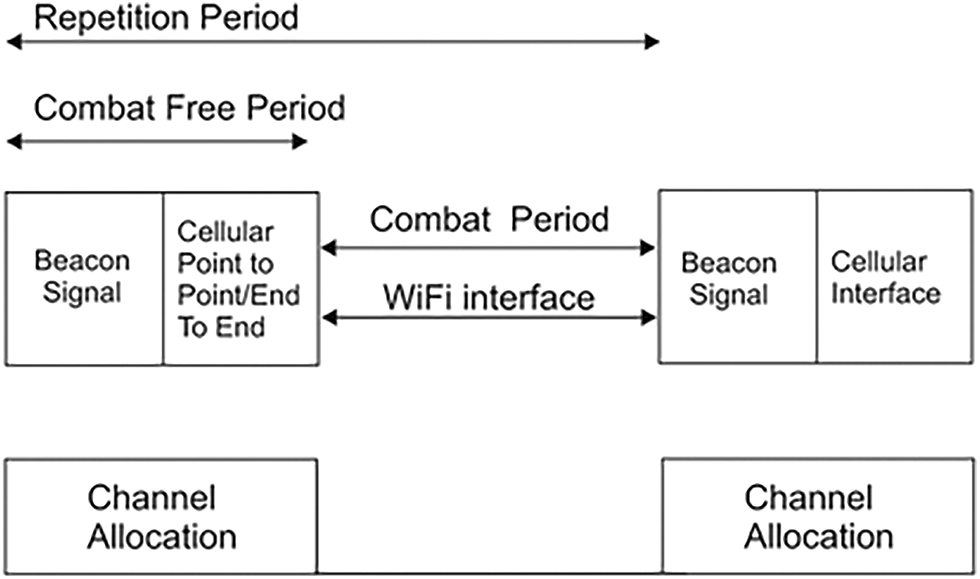
Figure 1: Structure of BAPC channel allocation
The proposed BAPC cellular allocation has three significant favorable circumstances. To begin with, since BAPC is conveyed by a solitary system specialist, it can all the more moderate the shared obstruction between the two systems through cautious edge synchronization in Fig. 2 and the executives of both authorized and unlicensed recurrence channels. As the Wi-Fi and cell passage at BAPC grow progressively, an effective channel asserts the executive system by utilizing its CSI information on cell endorsers. Finally, BAPC can let supporters keenly get to WiFi or cell and arrange for better QoS. It can affect the channel utility and deftly control the obligation cycle of the battle period and battle-free period to guarantee reasonable conjunction of the two frameworks and their endorsers. In this way, this paper centers around the endorser access and battle period channel assignment inside the proposed BAPC system to accomplish a reasonable and effective half and half system between Wi-Fi and cell systems.
There are three significant activity modes for cell organizing dependent on various control channel setups. For example, bearer conglomeration, time division, different access, and independent cell arrangement. The unlicensed band is in either the bearer collection mode or time division mode; the numerous entrance mode is utilized as a helper channel to transmit information, while the control flag still uses the authorized band. In independent cell mode, the two information and control signals must be transmitted on an unlicensed band without depending on the extra authorized band. The independent model offers a progressively adaptable means for cell organizing since it doesn’t rely upon the accessibility of an authorized band. Despite this, the model is the most testing one because of the nonattendance of the authorized band.

Figure 2: BAPC model for subscriber association and channel allocation
Hence, the N cell supporter, notwithstanding the I cell cross breed endorser, will be served during the battle free period utilizing the phone interface, while the M Wi-Fi endorsers, like the rest of the L − I half and half supporters, will be served during the battle time frame utilizing the Wi-Fi interface. We further signify the battle free period term and the battle time frame span in the battle free period reiteration period K as K − e and e, separately.
In this paper, one target for us is to determine the best qualities for both K and e to meet the presentation prerequisites of the three sorts of endorser needs. Additionally, the determination of half and half supporters for association with the cell interface ought to be examined. Wi-Fi Model Without loss of sweeping statement, we consider Wi-Fi in the 2.45 GHz unlicensed range to be consistent with the IEEE 802.11ac convention. For examination, we expect that the M + L − I stations are over-burdened with full cushions of information to transmit. All through our investigation, we utilized two execution measures. For example, the likelihood of WiFi and throughput upgrades. To get to the likelihood of WiFi, we let capacity least and limit greatest, separately, and indicate the base and most extreme dispute window estimates as characterized in IEEE 802.11 and shown in Fig. 3.
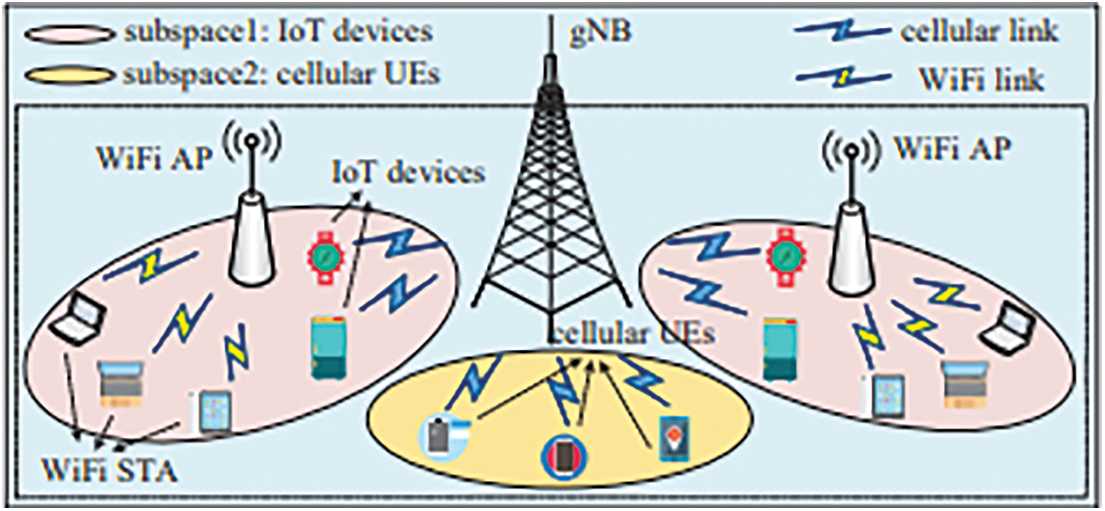
Figure 3: Cellular topological model of BAPC
In this cellular model, the licensed band during the combat-free period is utilized to serve both the cellular subscribers and the cellular hybrid subscribers without considering co-channel cellular interference. The SNR ratio of every subscriber X with a spectrum energy gain Gx to the serving BAPC an be written as
In eq. (1) where N0 is the Additive White Gaussian Noise (AWGN), B is the transfer speed for every supporter and is the transmitter intensity of each subscriber. Since the licensed spectrum for both Wi-Fi and cellular interfaces is isolated symmetrically, the impedance between Wi-Fi and cellular supporters in the equivalent BAPC can be ignored in this work. Henceforth, the entire impedance control IFx from all other Wi-Fi passages and serving BAPC can be written as
The attributes of the channel control gain Gx rely upon the channel blurring models and the channel information.
The presence of Wi-Fi and cellular interchanges will affect both cellular and Wi-Fi subscribers. In this way, we examine joint correspondence mode choice and frequency channel portion to limit the presentation debasement of cellular and Wi-Fi supporters brought about by the hybrid network. To be progressively explicit, we target boosting the enhanced throughput of cellular and Wi-Fi subscribers for a given information rate necessity of hybrid network subscribers.
BAPC Algorithm 1
The BAPC Algorithm for the FLT based unauthorized frequency channel allocation
STEP 1: Use the BAPC algorithm to locate the ideal unauthorized and authorized frequency channel reuse for every hybrid network subscriber.
STEP 2: Rearrange the throughput effect caused by hybrid network subscribers in expanding requests.
STEP 3: Examine the most extreme subscriber of permitted hybrid network subscribers on unauthorized and authorized channels.
STEP4: Find J = argmaximumF(J).
STEP5: Choose these J hybrid network subscribers to the unauthorized frequency channel utilizing the FLT technique.
The detailed steps of the BAPC algorithm for FLT based on unlicensed and licensed frequency channel access are summarized in Algorithm 1.
In this segment, Riverbed modeler 17.5 simulation results are presented to examine the performance of the proposed hybrid system subscriber connection and combat period channel allocation algorithm. We suppose that Wi-Fi subscribers, cellular subscribers, and hybrid subscribers all follow the Poisson distribution. Except if generally indicated, the quantity of Wi-Fi subscribers, cellular subscribers, and hybrid subscribers are 50, 150 and 250. The transmitter control at the BAPC is 15 dBm. We let the BAPC have a range of 50 m and the length of the point to guide the reiteration period to be 90 ms. Besides, we accept that cell, Wi-Fi and half-breed endorsers have a similar least information rate prerequisite of 2 Mbit/s. We embrace the IEEE 802.11n and IEEE 802.11 g CSMA/CA convention with the retransmit to send and clear to send systems working at the 2.45 GHz unlicensed range in the Riverbed in model 17.5 simulation tool. The remaining attributes are listed in Tab. 1.

We analyze the total utility gain in both cellular and Wi-Fi interfaces for various objective capacities and different channel fading models as shown in Fig. 4. From the outcomes in the figure, the best performance gain is likely to be achieved. Here, we assume that the channel information rate of the IEEE 802.11n framework is 100 Mbps, which is an ordinary incentive for 40 MHz channel data transmission. As it is, the comparative outcomes can be obtained for other channel information rates.
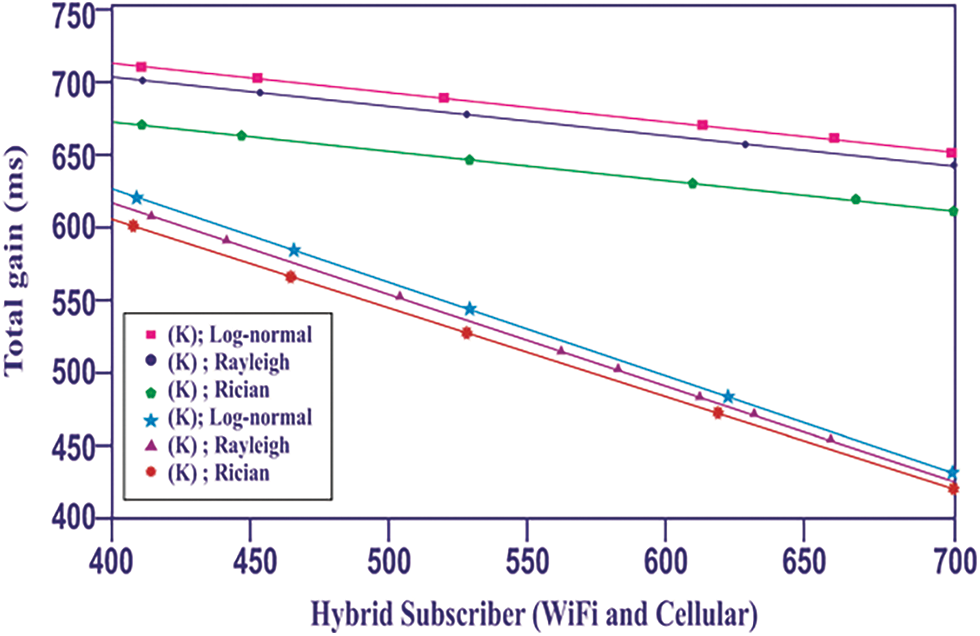
Figure 4: Total gain vs. Hybrid subscriber (Wi-Fi and Cellular)
The total gain of the HBBCS is underneath the greatest accomplished Ztotal.
Such an outcome is somewhat natural since the proposed HBBCS calculation considers the reasonableness between Wi-Fi and cellular subscribers. To give execution assurance to the Wi-Fi subscribers, a bigger combat period length might be distributed to the Wi-Fi interface and hybrid subscribers might be connected with the cellular network.
Fig. 5 shows the absolute throughput of Wi-Fi and the cell interfaces acquired by using the proposed HBBCS-based calculation.

Figure 5: Total throughput (Mbps/bits) vs. cellular subscriber
We analyze the exhibition of the proposed heterogeneous system and progressively customary cell concurrence methods. From the outcomes in this figure, we observe a critical presentation improvement of our proposition which is due to the misuse of channel state data at the BAPC. Note that BAPC can acquire the channel state data for supporter association and recurrence divert allotment in a concentrated manner, while the customary conjunction methods without Wi-Fi and cell coordination can’t profit by channel state data over the two interfaces. On the other hand, the overall throughput marginally drops with developing quantities of cell endorsers just as half-breed supporters. To guarantee decency, progressively half-breed supporters will be associated with the Wi-Fi interface as their number develops.
Fig. 6 shows that the quantity of cell crossover supporters in the BAPC structure is more prominent than that in conventional cellular systems. Simultaneously, the most extreme conflict time frame is low. The purpose behind such results is very clear. In the proposed BAPC structure, channel state data can be abused for supporter association to such an extent that those, half and half endorsers with more grounded channel increases will be picked for cell get to. Hence, increasingly cross breed supporters will be associated with cell interface to adjust decency with general framework throughput. Progressive cell supporters would require longer battle free periods, consequently bringing about the reduction of the most extreme battle period length.
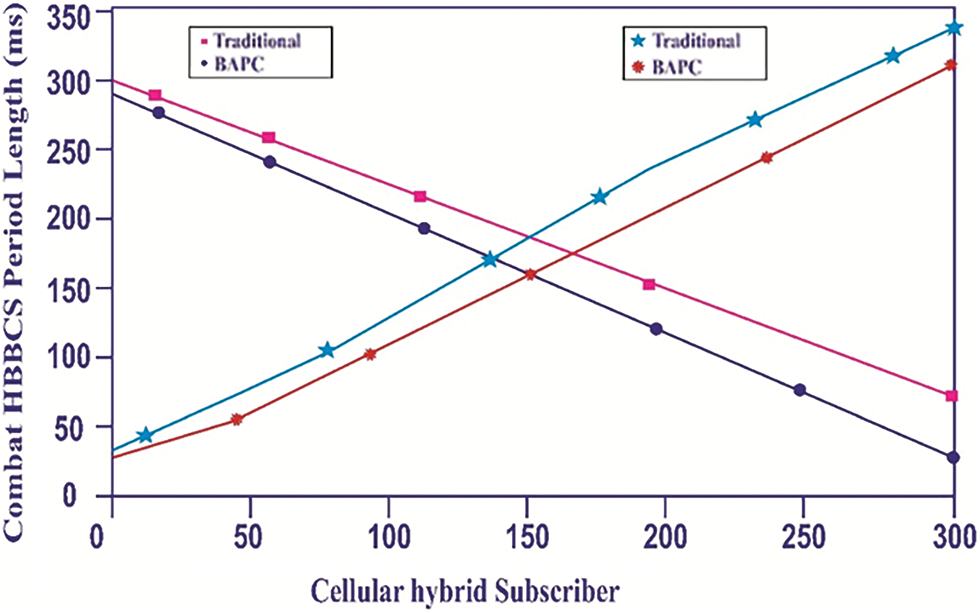
Figure 6: Combat HBBCS period length (ms) vs. cellular hybrid subscriber
Then we can see that the number of cell mixture supporters diminishes, while the most extreme battle time frame length increments with a developing number of Wi-Fi supporters that request longer battle periods for administration.
Fig. 7 shows the presentation examination between the proposed system and two other conventional cell and Wi-Fi concurrence methods, specifically, FLT and obligation cycle at zero, as far as the normal throughput improvement. In the obligation cycle at zero, we expect that cell and Wi-Fi are given equivalent vacancies to transmit. From the test outcomes, our proposed method consistently gives the best execution, which is a lot higher than the other two customary methods. The exhibition, on the whole, turns out to be progressively clear with a developing number of served supporters. Since the measure of accessible unlicensed recurrence channel diminishes with the number of endorsers in the framework, the normal throughput improvement additionally decreases as needs be. In addition, when the quantity of endorsers in the system is small, FLT shows better execution than the obligation cycle at zero. At the point when the supporter number is enormous, the obligation cycle at zero becomes superior to the FLT procedure.
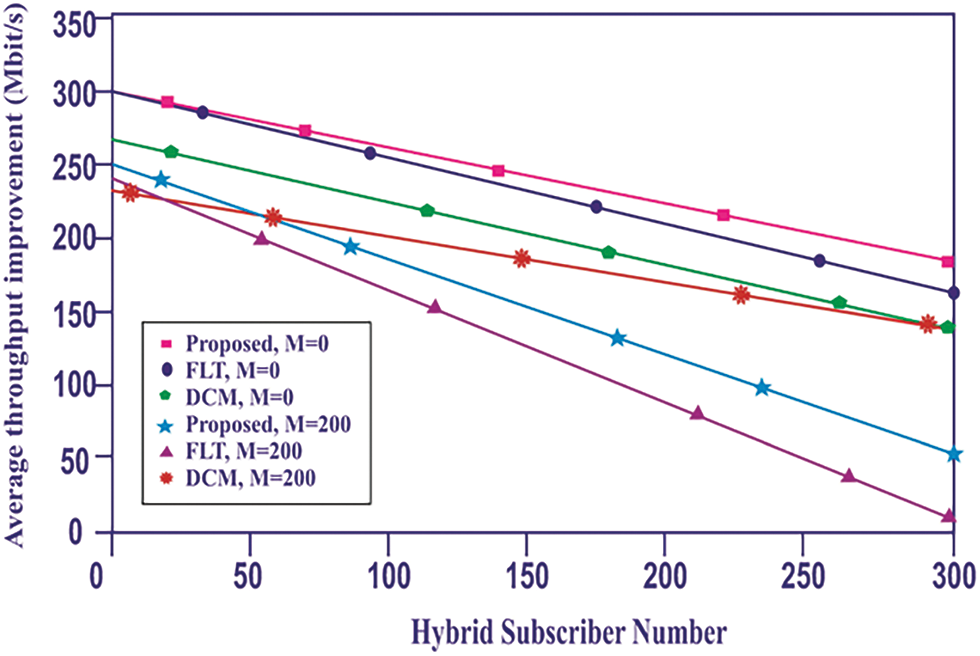
Figure 7: Average throughput improvement (Mbits/s) vs. hybrid subscriber number
The explanation is that, in low thickness situations, the framework load is small and supporters would seldom cause a signal crash. In this manner, FLT is very proficient. Furthermore, the proposed strategy doesn’t show a generous favorable position.
This paper investigates effective channel allocation under a novel BAPC structure for the cellular and Wi-Fi in unlicensed frequency channels involved by occupant Wi-Fi subscribers. Our research focused on improving the performance of cellular and Wi-Fi conjunction inside the BAPC system. To abstain from disturbing the inheritance of Wi-Fi subscribers, we embrace the point of direct coordination and end-to-end coordination access conventions previously institutionalized in the IEEE 802.11 protocol to partition the unauthorized frequency into a combat period for Wi-Fi communication and a combat free period for cellular communication. By taking out Wi-Fi and cellular obstructions without changing the similarity with heritage Wi-Fi subscriber gadgets, frequency channel resource proficiency of unauthorized channels can be additionally improved by the more proficient cellular subscriber. Inside the BAPC structure, we have additionally accentuated the joint subscriber station and combat period allotment issue to upgrade the framework throughput and subscriber reasonableness. We also infer a closed-form articulation for the ideal battle length to enhance the HBBCS-based system utility capacity. Our outcomes illustrate the viable improvement of the novel heterogeneous system when contrasted with progressively customary cellular deployment within the presence of Wi-Fi subscribers.
Acknowledgement: Our sincere thanks to our institution management for their constant motivation and encouragement to publish our research ideas in this esteemed journal. Our heartfelt thanks to Dr. T. R. Ganesh Babu and Mr. V. Rajasekaran for their constant support in bringing out this research work with good findings.
Funding Statement: We have not received any specific funding for this study.
Conflicts of Interest: We hereby declare that we do not have any conflict of interest to report regarding the present study.
1. Q. Chen, G. Yu, H. Shan, A. Maaref, G. Y. Li et al., “An opportunistic unlicensed spectrum utilization method for LTE and Wi-Fi coexistence system,” in 2015 IEEE Global Communications Conf. (GLOBECOM), San Diego, CA, USA, pp. 1–6, 2015. [Google Scholar]
2. A. Aijaz, H. Aghvami and M. Amani, “A survey on mobile data offloading: Technical and business perspectives,” IEEE Wireless Communications, vol. 20, no. 2, pp. 104–112, 2013. [Google Scholar]
3. K. Lee, J. Lee, Y. Yi, I. Rhee and S. Chong, “Mobile data offloading: How much can Wi-Fi deliver?,” IEEE/ACM Transactions on Networking, vol. 21, no. 2, pp. 536–550, 2013. [Google Scholar]
4. M. Bennis, M. Simsek, A. Czylwik, W. Saad, S. Valentin et al., “When cellular meets Wi-Fi in wireless small cell networks?,” IEEE Communications Magazine, vol. 51, no. 6, pp. 44–50, 2013. [Google Scholar]
5. B. H. Jung, N. Song and D. K. Sung, “A network-assisted user-centric Wi-Fi-offloading model for maximizing per-user throughput in a heterogeneous network,” IEEE Transactions on Vehicular Technology, vol. 63, no. 4, pp. 1940–1945, 2014. [Google Scholar]
6. S. Singh, H. S. Dhillon and J. G. Andrews, “Offloading in heterogeneous networks: Modeling, analysis, design insights,” IEEE Transactions on Wireless Communications, vol. 12, no. 5, pp. 2484–2497, 2013. [Google Scholar]
7. Q. Ye, B. Rong, Y. Chen, M. Al-Shalash, C. Caramanis et al., “User association for load balancing in heterogeneous cellular networks,” IEEE Transactions on Wireless Communications, vol. 12, no. 6, pp. 2706–2716, 2013. [Google Scholar]
8. G. Lin, G. Oosifidis, J. Huang, L. Tassiulas and D. Li, “Bargaining based mobile data offloading,” IEEE Journal on Selected Areas in Communications, vol. 32, no. 6, pp. 1114–1125, 2014. [Google Scholar]
9. H. Zhang, X. Chu, W. Guo and S. Wang, “Coexistence of Wi-Fi and heterogeneous small cell networks sharing unlicensed spectrum,” IEEE Communications Magazine, vol. 53, no. 3, pp. 158–164, 2015. [Google Scholar]
10. L. Berlemann, C. Hoymann, G. Hiertz and B. Walke, “Unlicensed operation of IEEE 802.16: Coexistence with 802.11a in shared frequency bands,” in IEEE 17th Int. Sym. on Personal, Indoor and Mobile Radio Communications, Helsinki, Finland, pp. 1–5, 2006. [Google Scholar]
11. A. R. Elsherif, W. P. Chen, A. Ito and Z. Ding, “Resource allocation and inter-Cell interference management for Dual-Access small cells,” IEEE Journal on Selected Areas in Communications, vol. 33, no. 6, pp. 1082–1096, 2015. [Google Scholar]
12. F. Liu, E. Erkip, M. C. Beluri, R. Yang and E. Bala, “Dual-band femtocell traffic balancing over licensed and unlicensed bands,” in 2012 IEEE Int. Conf. on Communications (ICC), Ottawa, ON, Canada, pp. 1–6, 2012. [Google Scholar]
13. F. Liu, E. Bala, E. Erkip, M. Beluri and R. Yang, “Small cell traffic balancing over licensed and unlicensed bands,” 2012 IEEE International Conference on Communications (ICC), vol. 64, no. 12, pp. 5850–5865, 2015. [Google Scholar]
14. G. Bianchi, “Performance analysis of IEEE 802.11 distributed coordination function,” IEEE Journal on Selected Areas in Communications, vol. 18, no. 3, pp. 535–547, 2000. [Google Scholar]
15. G. Bianchi and I. Tinnirello, “Kalman filter estimation of the number of competing terminals in an IEEE 802.11 network,” Twenty-second Annual Joint Conference of the IEEE Computer and Communications Societies, vol. 2, pp. 844–852, 2003. [Google Scholar]
16. D. Malone, K. Duffy and D. Leith, “Modeling the 802.11 distributed coordination function in non-saturated heterogeneous conditions,” IEEE/ACM Transactions on Networking, vol. 15, no. 1, pp. 159–172, 2007. [Google Scholar]
17. A. R. Elsherif, W. P. Chen, A. Ito and Z. Ding, “Resource allocation and inter-cell interference management for dual-access small cells,” IEEE Journal on Selected Areas in Communications, vol. 33, no. 6, pp. 1082–1096, 2015. [Google Scholar]
18. F. Liu, E. Bala, E. Erkip, M. C. Beluri and R. Yang, “Small-cell trafficbalancing over licensed and unlicensed bands,” IEEE Transactions on Vehicular Technology, vol. 64, no. 12, pp. 5850–5865, 2015. [Google Scholar]
19. S. Dama, A. Kumar and K. Kuchi, “Performance evaluation of LAA-LBTbased LTE and WLAN’s co-existence in unlicensed spectrum,” IEEE Globecom Workshops (GC Wkshps), pp. 1–6, 2015. https://dx.doi.org/10.1109/GLOCOMW.2015.7414071. [Google Scholar]
20. G. Ding, J. Wang, Q. Wu, Y. D. Yao, R. Li et al., “On the limits of predictability in real-world radio spectrum state dynamics: From entropy theory to 5G spectrum sharing,” IEEE Wireless Communications, vol. 22, no. 3, pp. 150–159, 2015. [Google Scholar]
21. R. Zhang, M. Wang, X. Cai, Z. Zheng, X. Shen et al., “LTE unlicensed: The future of spectrum aggregation for cellular networks,” IEEE Communications Magazine, vol. 53, no. 3, pp. 158–164, 2015. [Google Scholar]
22. H. Zhang, X. Chu, W. Guo and S. Wang, “Coexistence of Wi-Fi and heterogeneous small cell networks sharing unlicensed spectrum,” IEEE Communications Magazine, vol. 53, no. 3, pp. 158–164, 2015. [Google Scholar]
23. A. R. Elsherif, W. P. Chen, A. Ito and Z. Ding, “Resource allocation and inter-cell interference management for dual-access small cells,” IEEE Journal on Selected Areas in Communications, vol. 33, no. 6, pp. 1082–1096, 2015. [Google Scholar]
24. Q. Chen, G. Yu, R. Yin, A. Maaref, G. Y. Li et al., “Energy efficiency optimization in licensed-assisted access,” IEEE Journal on Selected Areas in Communications, vol. 34, no. 4, pp. 723–734, 2016. [Google Scholar]
25. Q. Chen, G. Yu, H. Shan, A. Maaref, G. Y. Li et al., “Cellular meets Wi-Fi: Traffic offloading or resource sharing?,” IEEE Transactions on Wireless Communications, vol. 15, no. 5, pp. 3354–3367, 2016. [Google Scholar]
26. O. Sadio, I. Ngom and C. Lishou, “Controlling Wifi direct group formation for non-critical applications in C-V2X network,” IEEE Access, vol. 8, pp. 79947–79957, 2020. [Google Scholar]
27. T. Xie, G. H. Tu, B. Yin, C. Y. Li, C. Peng et al., “The untold secrets of Wifi-calling services: Vulnerabilities, attacks, and countermeasures,” IEEE Transactions on Mobile Computing, vol. 20, no. 11, pp. 3131–3147, 2021. [Google Scholar]
28. S. Zhao and Z. Zhu, “On virtual network reconfiguration in hybrid optical/electrical datacenter networks,” Journal of Lightwave Technology, vol. 38, pp. 23, 2020. [Google Scholar]
29. X. Jiang, H. Zhang, E. A. Barsallo Yi, N. Raghunathan, C. Mousoulis et al., “Hybrid low-power wide-area mesh network for IoT applications,” IEEE Internet of Things Journal, vol. 8, no. 2, pp. 901–915, 2021. [Google Scholar]
30. H. Geng, H. Zhang, X. Shi, Z. Wang, X. Yin et al., “A hybrid link protection scheme for ensuring network service availability in link-state routing networks,” Journal of Communications and Networks, vol. 22, no. 1, pp. 46–60, 2020. [Google Scholar]
31. S. Yin, Z. Zhang, C. Yang, Y. Chu and S. Huang, “Prediction-based end-to-end dynamic network slicing in hybrid elastic fiber-wireless networks,” Journal of Lightwave Technology, vol. 39, no. 7, pp. 1889–1899, 2021. [Google Scholar]
 | This work is licensed under a Creative Commons Attribution 4.0 International License, which permits unrestricted use, distribution, and reproduction in any medium, provided the original work is properly cited. |